Financial Management: Literature Review on Risk in Bonds and Sukuk
VerifiedAdded on 2022/08/13
|13
|3679
|13
Report
AI Summary
This literature review delves into the critical role of risk management in finance, emphasizing the importance of understanding and mitigating various financial risks. The report focuses on the risks associated with financial instruments, particularly bonds and Sukuk, exploring types such as business risk, liquidity risk, inflation risk, volatility risk, and interest rate risk. It examines the characteristics of bonds, including interest rate risk, inflation risk, reinvestment risk, credit risk, and liquidity risk. Furthermore, the report provides a comparative analysis of Sukuk and conventional bonds, highlighting the unique risk factors associated with Sukuk, such as market risk and idiosyncratic risk. The analysis includes a discussion of how bond ratings are determined and the implications of credit risk. This comprehensive overview aims to provide a detailed understanding of financial risk management in the context of bonds and Sukuk, offering valuable insights for investors and financial professionals.
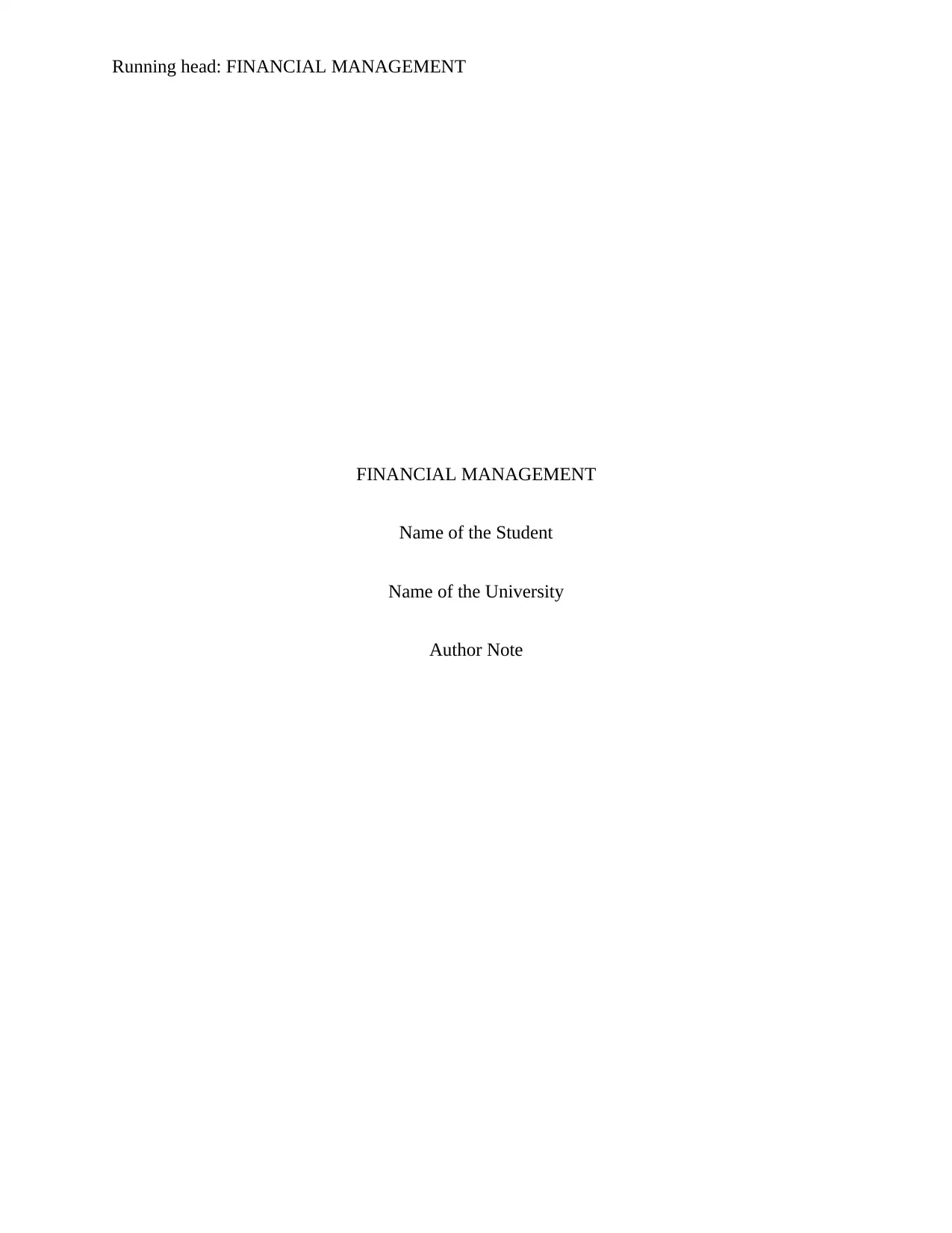
Running head: FINANCIAL MANAGEMENT
FINANCIAL MANAGEMENT
Name of the Student
Name of the University
Author Note
FINANCIAL MANAGEMENT
Name of the Student
Name of the University
Author Note
Paraphrase This Document
Need a fresh take? Get an instant paraphrase of this document with our AI Paraphraser
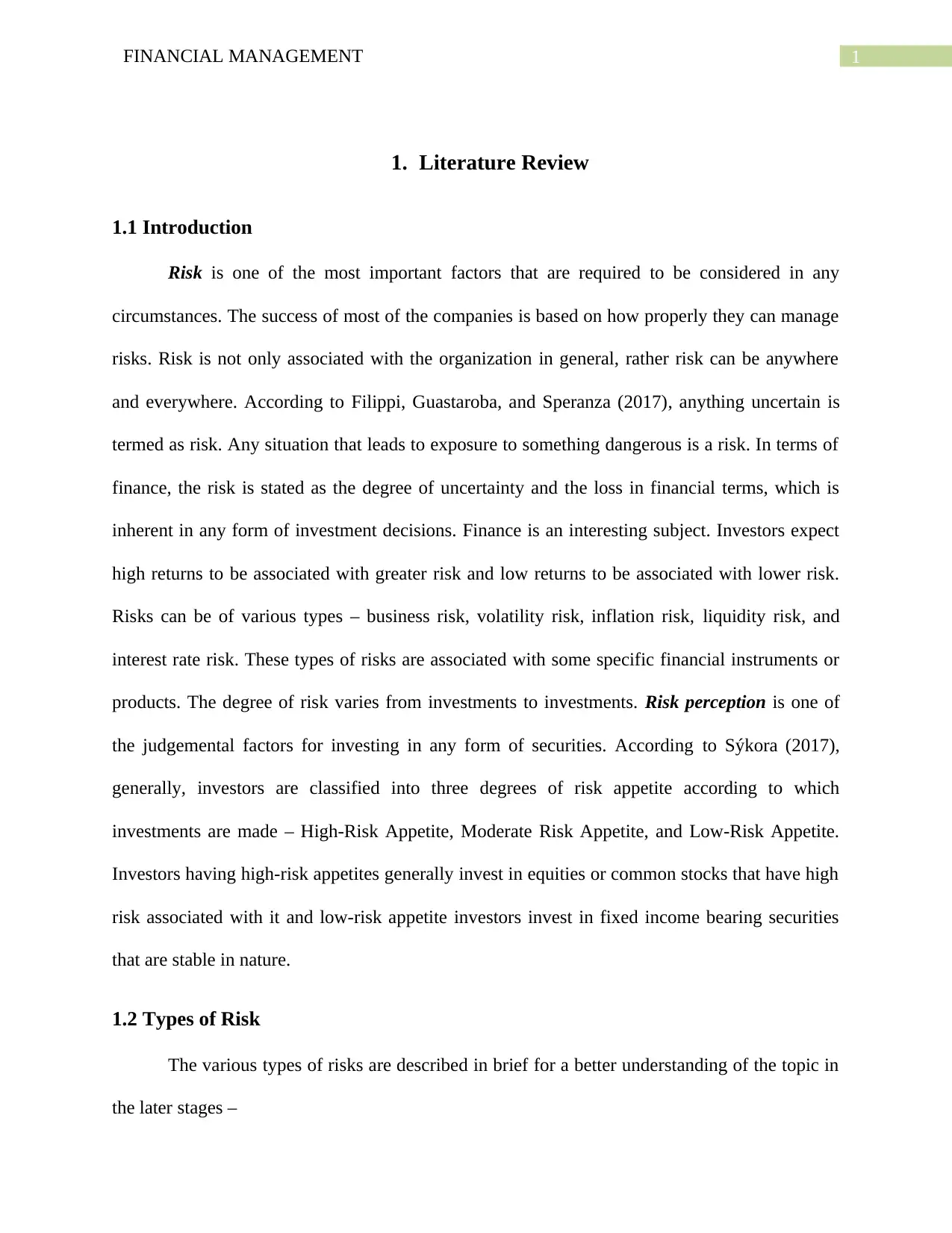
1FINANCIAL MANAGEMENT
1. Literature Review
1.1 Introduction
Risk is one of the most important factors that are required to be considered in any
circumstances. The success of most of the companies is based on how properly they can manage
risks. Risk is not only associated with the organization in general, rather risk can be anywhere
and everywhere. According to Filippi, Guastaroba, and Speranza (2017), anything uncertain is
termed as risk. Any situation that leads to exposure to something dangerous is a risk. In terms of
finance, the risk is stated as the degree of uncertainty and the loss in financial terms, which is
inherent in any form of investment decisions. Finance is an interesting subject. Investors expect
high returns to be associated with greater risk and low returns to be associated with lower risk.
Risks can be of various types – business risk, volatility risk, inflation risk, liquidity risk, and
interest rate risk. These types of risks are associated with some specific financial instruments or
products. The degree of risk varies from investments to investments. Risk perception is one of
the judgemental factors for investing in any form of securities. According to Sýkora (2017),
generally, investors are classified into three degrees of risk appetite according to which
investments are made – High-Risk Appetite, Moderate Risk Appetite, and Low-Risk Appetite.
Investors having high-risk appetites generally invest in equities or common stocks that have high
risk associated with it and low-risk appetite investors invest in fixed income bearing securities
that are stable in nature.
1.2 Types of Risk
The various types of risks are described in brief for a better understanding of the topic in
the later stages –
1. Literature Review
1.1 Introduction
Risk is one of the most important factors that are required to be considered in any
circumstances. The success of most of the companies is based on how properly they can manage
risks. Risk is not only associated with the organization in general, rather risk can be anywhere
and everywhere. According to Filippi, Guastaroba, and Speranza (2017), anything uncertain is
termed as risk. Any situation that leads to exposure to something dangerous is a risk. In terms of
finance, the risk is stated as the degree of uncertainty and the loss in financial terms, which is
inherent in any form of investment decisions. Finance is an interesting subject. Investors expect
high returns to be associated with greater risk and low returns to be associated with lower risk.
Risks can be of various types – business risk, volatility risk, inflation risk, liquidity risk, and
interest rate risk. These types of risks are associated with some specific financial instruments or
products. The degree of risk varies from investments to investments. Risk perception is one of
the judgemental factors for investing in any form of securities. According to Sýkora (2017),
generally, investors are classified into three degrees of risk appetite according to which
investments are made – High-Risk Appetite, Moderate Risk Appetite, and Low-Risk Appetite.
Investors having high-risk appetites generally invest in equities or common stocks that have high
risk associated with it and low-risk appetite investors invest in fixed income bearing securities
that are stable in nature.
1.2 Types of Risk
The various types of risks are described in brief for a better understanding of the topic in
the later stages –
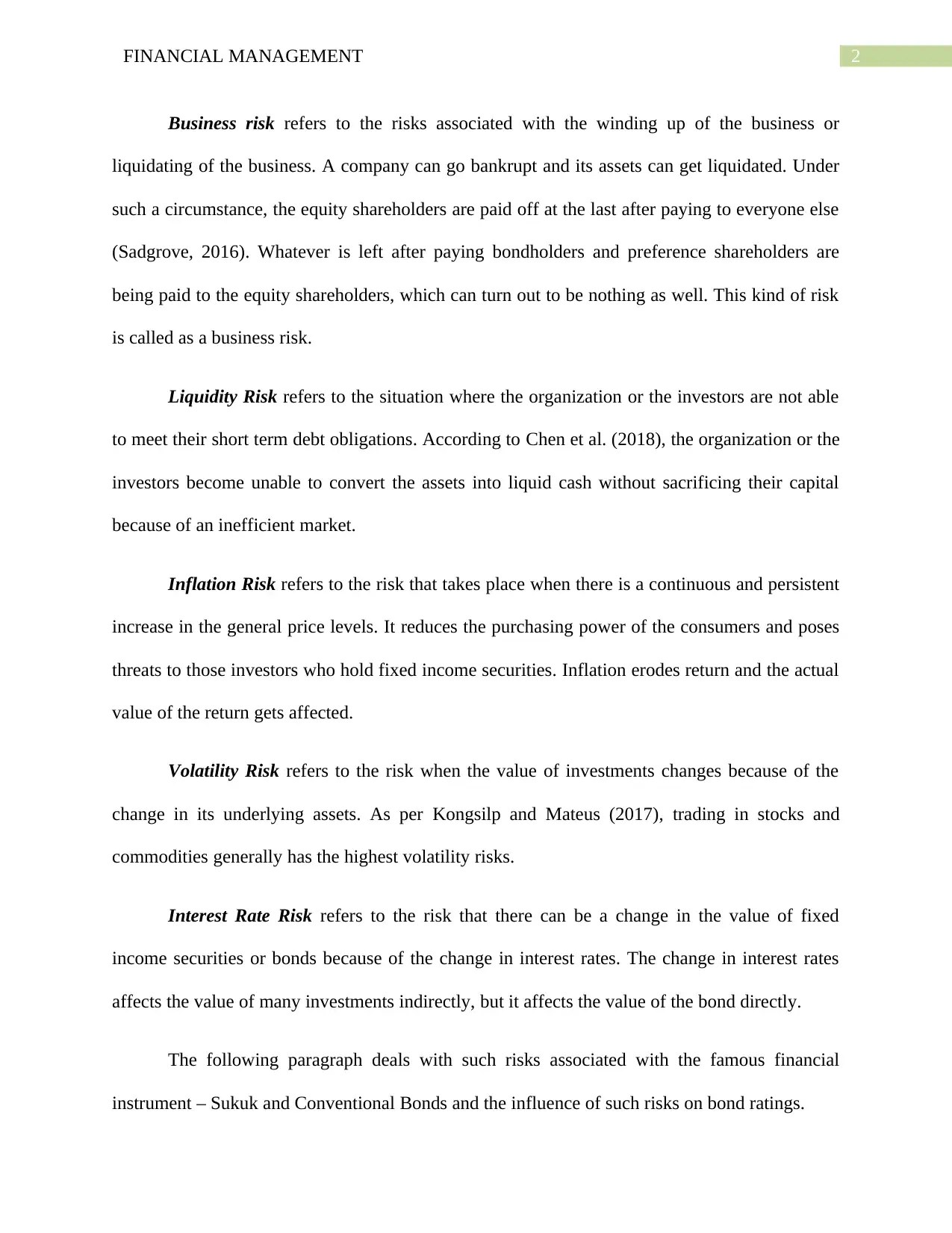
2FINANCIAL MANAGEMENT
Business risk refers to the risks associated with the winding up of the business or
liquidating of the business. A company can go bankrupt and its assets can get liquidated. Under
such a circumstance, the equity shareholders are paid off at the last after paying to everyone else
(Sadgrove, 2016). Whatever is left after paying bondholders and preference shareholders are
being paid to the equity shareholders, which can turn out to be nothing as well. This kind of risk
is called as a business risk.
Liquidity Risk refers to the situation where the organization or the investors are not able
to meet their short term debt obligations. According to Chen et al. (2018), the organization or the
investors become unable to convert the assets into liquid cash without sacrificing their capital
because of an inefficient market.
Inflation Risk refers to the risk that takes place when there is a continuous and persistent
increase in the general price levels. It reduces the purchasing power of the consumers and poses
threats to those investors who hold fixed income securities. Inflation erodes return and the actual
value of the return gets affected.
Volatility Risk refers to the risk when the value of investments changes because of the
change in its underlying assets. As per Kongsilp and Mateus (2017), trading in stocks and
commodities generally has the highest volatility risks.
Interest Rate Risk refers to the risk that there can be a change in the value of fixed
income securities or bonds because of the change in interest rates. The change in interest rates
affects the value of many investments indirectly, but it affects the value of the bond directly.
The following paragraph deals with such risks associated with the famous financial
instrument – Sukuk and Conventional Bonds and the influence of such risks on bond ratings.
Business risk refers to the risks associated with the winding up of the business or
liquidating of the business. A company can go bankrupt and its assets can get liquidated. Under
such a circumstance, the equity shareholders are paid off at the last after paying to everyone else
(Sadgrove, 2016). Whatever is left after paying bondholders and preference shareholders are
being paid to the equity shareholders, which can turn out to be nothing as well. This kind of risk
is called as a business risk.
Liquidity Risk refers to the situation where the organization or the investors are not able
to meet their short term debt obligations. According to Chen et al. (2018), the organization or the
investors become unable to convert the assets into liquid cash without sacrificing their capital
because of an inefficient market.
Inflation Risk refers to the risk that takes place when there is a continuous and persistent
increase in the general price levels. It reduces the purchasing power of the consumers and poses
threats to those investors who hold fixed income securities. Inflation erodes return and the actual
value of the return gets affected.
Volatility Risk refers to the risk when the value of investments changes because of the
change in its underlying assets. As per Kongsilp and Mateus (2017), trading in stocks and
commodities generally has the highest volatility risks.
Interest Rate Risk refers to the risk that there can be a change in the value of fixed
income securities or bonds because of the change in interest rates. The change in interest rates
affects the value of many investments indirectly, but it affects the value of the bond directly.
The following paragraph deals with such risks associated with the famous financial
instrument – Sukuk and Conventional Bonds and the influence of such risks on bond ratings.
⊘ This is a preview!⊘
Do you want full access?
Subscribe today to unlock all pages.

Trusted by 1+ million students worldwide
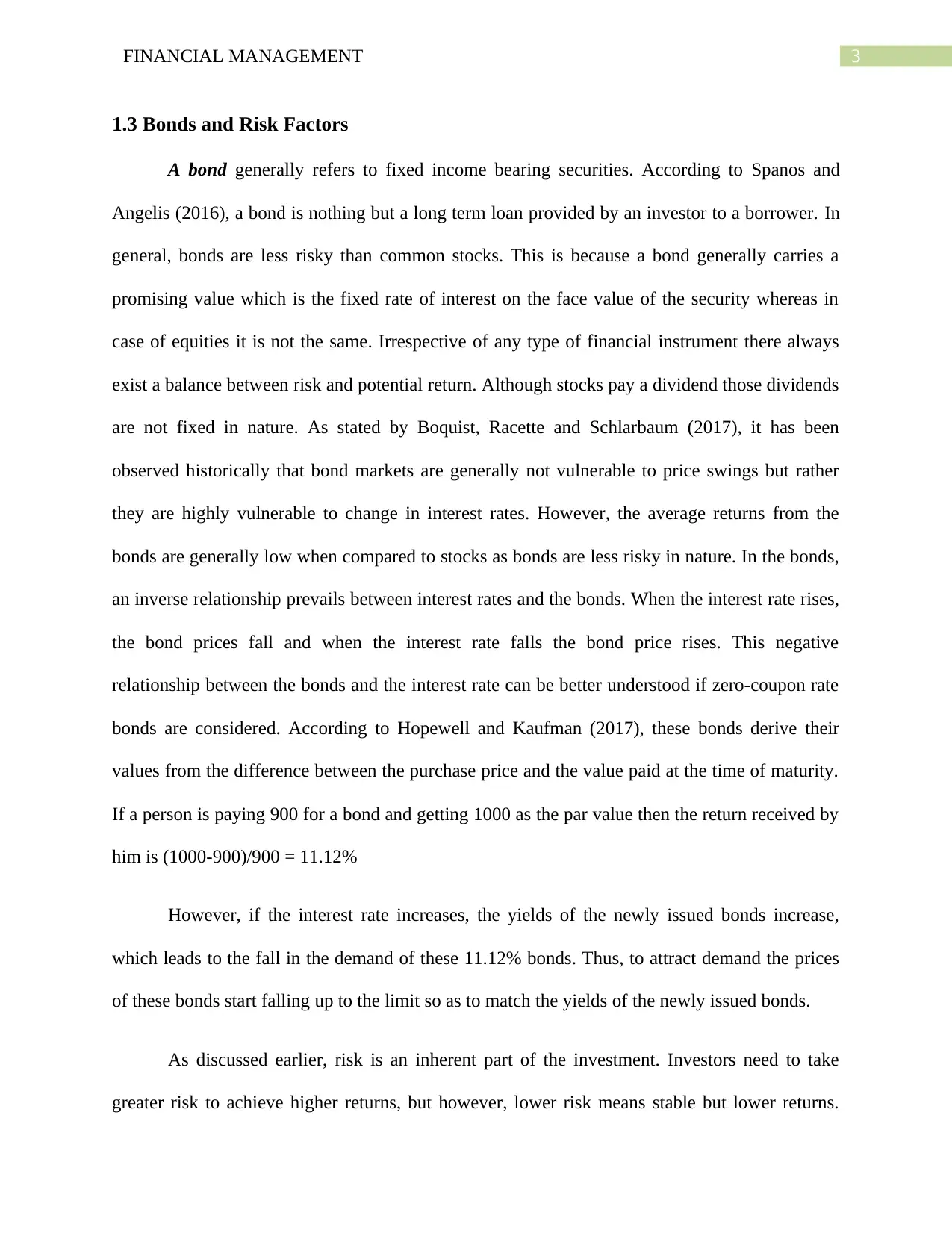
3FINANCIAL MANAGEMENT
1.3 Bonds and Risk Factors
A bond generally refers to fixed income bearing securities. According to Spanos and
Angelis (2016), a bond is nothing but a long term loan provided by an investor to a borrower. In
general, bonds are less risky than common stocks. This is because a bond generally carries a
promising value which is the fixed rate of interest on the face value of the security whereas in
case of equities it is not the same. Irrespective of any type of financial instrument there always
exist a balance between risk and potential return. Although stocks pay a dividend those dividends
are not fixed in nature. As stated by Boquist, Racette and Schlarbaum (2017), it has been
observed historically that bond markets are generally not vulnerable to price swings but rather
they are highly vulnerable to change in interest rates. However, the average returns from the
bonds are generally low when compared to stocks as bonds are less risky in nature. In the bonds,
an inverse relationship prevails between interest rates and the bonds. When the interest rate rises,
the bond prices fall and when the interest rate falls the bond price rises. This negative
relationship between the bonds and the interest rate can be better understood if zero-coupon rate
bonds are considered. According to Hopewell and Kaufman (2017), these bonds derive their
values from the difference between the purchase price and the value paid at the time of maturity.
If a person is paying 900 for a bond and getting 1000 as the par value then the return received by
him is (1000-900)/900 = 11.12%
However, if the interest rate increases, the yields of the newly issued bonds increase,
which leads to the fall in the demand of these 11.12% bonds. Thus, to attract demand the prices
of these bonds start falling up to the limit so as to match the yields of the newly issued bonds.
As discussed earlier, risk is an inherent part of the investment. Investors need to take
greater risk to achieve higher returns, but however, lower risk means stable but lower returns.
1.3 Bonds and Risk Factors
A bond generally refers to fixed income bearing securities. According to Spanos and
Angelis (2016), a bond is nothing but a long term loan provided by an investor to a borrower. In
general, bonds are less risky than common stocks. This is because a bond generally carries a
promising value which is the fixed rate of interest on the face value of the security whereas in
case of equities it is not the same. Irrespective of any type of financial instrument there always
exist a balance between risk and potential return. Although stocks pay a dividend those dividends
are not fixed in nature. As stated by Boquist, Racette and Schlarbaum (2017), it has been
observed historically that bond markets are generally not vulnerable to price swings but rather
they are highly vulnerable to change in interest rates. However, the average returns from the
bonds are generally low when compared to stocks as bonds are less risky in nature. In the bonds,
an inverse relationship prevails between interest rates and the bonds. When the interest rate rises,
the bond prices fall and when the interest rate falls the bond price rises. This negative
relationship between the bonds and the interest rate can be better understood if zero-coupon rate
bonds are considered. According to Hopewell and Kaufman (2017), these bonds derive their
values from the difference between the purchase price and the value paid at the time of maturity.
If a person is paying 900 for a bond and getting 1000 as the par value then the return received by
him is (1000-900)/900 = 11.12%
However, if the interest rate increases, the yields of the newly issued bonds increase,
which leads to the fall in the demand of these 11.12% bonds. Thus, to attract demand the prices
of these bonds start falling up to the limit so as to match the yields of the newly issued bonds.
As discussed earlier, risk is an inherent part of the investment. Investors need to take
greater risk to achieve higher returns, but however, lower risk means stable but lower returns.
Paraphrase This Document
Need a fresh take? Get an instant paraphrase of this document with our AI Paraphraser
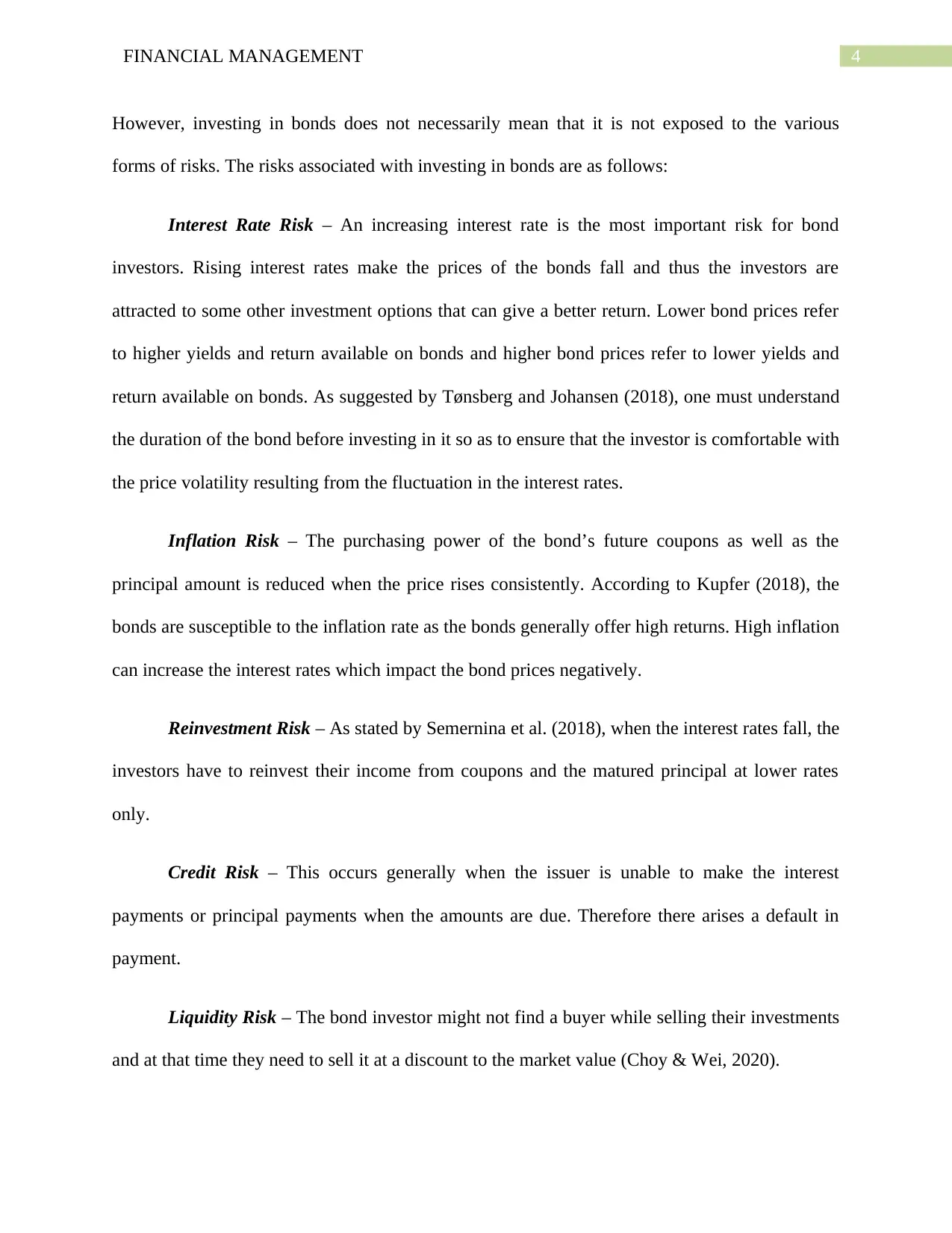
4FINANCIAL MANAGEMENT
However, investing in bonds does not necessarily mean that it is not exposed to the various
forms of risks. The risks associated with investing in bonds are as follows:
Interest Rate Risk – An increasing interest rate is the most important risk for bond
investors. Rising interest rates make the prices of the bonds fall and thus the investors are
attracted to some other investment options that can give a better return. Lower bond prices refer
to higher yields and return available on bonds and higher bond prices refer to lower yields and
return available on bonds. As suggested by Tønsberg and Johansen (2018), one must understand
the duration of the bond before investing in it so as to ensure that the investor is comfortable with
the price volatility resulting from the fluctuation in the interest rates.
Inflation Risk – The purchasing power of the bond’s future coupons as well as the
principal amount is reduced when the price rises consistently. According to Kupfer (2018), the
bonds are susceptible to the inflation rate as the bonds generally offer high returns. High inflation
can increase the interest rates which impact the bond prices negatively.
Reinvestment Risk – As stated by Semernina et al. (2018), when the interest rates fall, the
investors have to reinvest their income from coupons and the matured principal at lower rates
only.
Credit Risk – This occurs generally when the issuer is unable to make the interest
payments or principal payments when the amounts are due. Therefore there arises a default in
payment.
Liquidity Risk – The bond investor might not find a buyer while selling their investments
and at that time they need to sell it at a discount to the market value (Choy & Wei, 2020).
However, investing in bonds does not necessarily mean that it is not exposed to the various
forms of risks. The risks associated with investing in bonds are as follows:
Interest Rate Risk – An increasing interest rate is the most important risk for bond
investors. Rising interest rates make the prices of the bonds fall and thus the investors are
attracted to some other investment options that can give a better return. Lower bond prices refer
to higher yields and return available on bonds and higher bond prices refer to lower yields and
return available on bonds. As suggested by Tønsberg and Johansen (2018), one must understand
the duration of the bond before investing in it so as to ensure that the investor is comfortable with
the price volatility resulting from the fluctuation in the interest rates.
Inflation Risk – The purchasing power of the bond’s future coupons as well as the
principal amount is reduced when the price rises consistently. According to Kupfer (2018), the
bonds are susceptible to the inflation rate as the bonds generally offer high returns. High inflation
can increase the interest rates which impact the bond prices negatively.
Reinvestment Risk – As stated by Semernina et al. (2018), when the interest rates fall, the
investors have to reinvest their income from coupons and the matured principal at lower rates
only.
Credit Risk – This occurs generally when the issuer is unable to make the interest
payments or principal payments when the amounts are due. Therefore there arises a default in
payment.
Liquidity Risk – The bond investor might not find a buyer while selling their investments
and at that time they need to sell it at a discount to the market value (Choy & Wei, 2020).
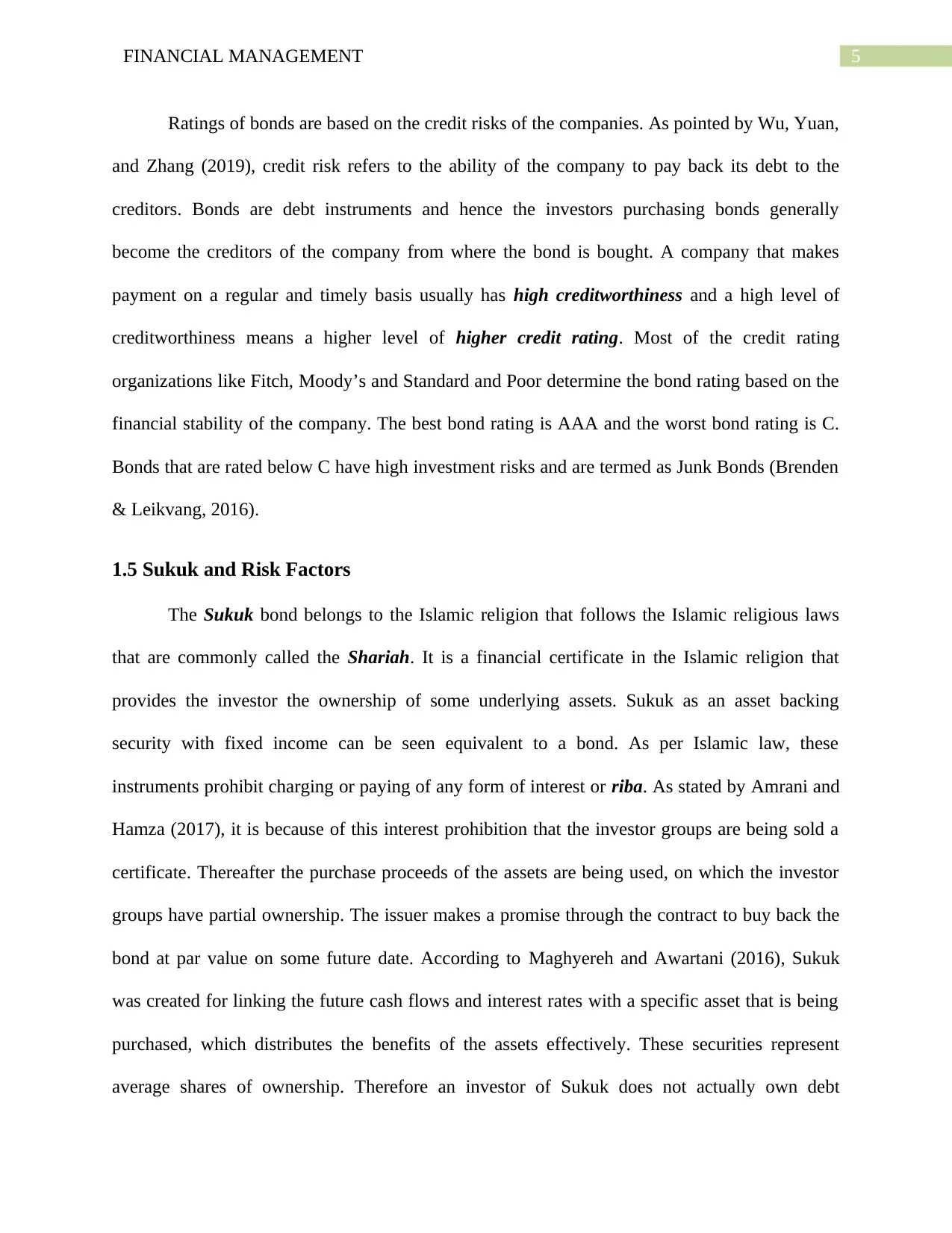
5FINANCIAL MANAGEMENT
Ratings of bonds are based on the credit risks of the companies. As pointed by Wu, Yuan,
and Zhang (2019), credit risk refers to the ability of the company to pay back its debt to the
creditors. Bonds are debt instruments and hence the investors purchasing bonds generally
become the creditors of the company from where the bond is bought. A company that makes
payment on a regular and timely basis usually has high creditworthiness and a high level of
creditworthiness means a higher level of higher credit rating. Most of the credit rating
organizations like Fitch, Moody’s and Standard and Poor determine the bond rating based on the
financial stability of the company. The best bond rating is AAA and the worst bond rating is C.
Bonds that are rated below C have high investment risks and are termed as Junk Bonds (Brenden
& Leikvang, 2016).
1.5 Sukuk and Risk Factors
The Sukuk bond belongs to the Islamic religion that follows the Islamic religious laws
that are commonly called the Shariah. It is a financial certificate in the Islamic religion that
provides the investor the ownership of some underlying assets. Sukuk as an asset backing
security with fixed income can be seen equivalent to a bond. As per Islamic law, these
instruments prohibit charging or paying of any form of interest or riba. As stated by Amrani and
Hamza (2017), it is because of this interest prohibition that the investor groups are being sold a
certificate. Thereafter the purchase proceeds of the assets are being used, on which the investor
groups have partial ownership. The issuer makes a promise through the contract to buy back the
bond at par value on some future date. According to Maghyereh and Awartani (2016), Sukuk
was created for linking the future cash flows and interest rates with a specific asset that is being
purchased, which distributes the benefits of the assets effectively. These securities represent
average shares of ownership. Therefore an investor of Sukuk does not actually own debt
Ratings of bonds are based on the credit risks of the companies. As pointed by Wu, Yuan,
and Zhang (2019), credit risk refers to the ability of the company to pay back its debt to the
creditors. Bonds are debt instruments and hence the investors purchasing bonds generally
become the creditors of the company from where the bond is bought. A company that makes
payment on a regular and timely basis usually has high creditworthiness and a high level of
creditworthiness means a higher level of higher credit rating. Most of the credit rating
organizations like Fitch, Moody’s and Standard and Poor determine the bond rating based on the
financial stability of the company. The best bond rating is AAA and the worst bond rating is C.
Bonds that are rated below C have high investment risks and are termed as Junk Bonds (Brenden
& Leikvang, 2016).
1.5 Sukuk and Risk Factors
The Sukuk bond belongs to the Islamic religion that follows the Islamic religious laws
that are commonly called the Shariah. It is a financial certificate in the Islamic religion that
provides the investor the ownership of some underlying assets. Sukuk as an asset backing
security with fixed income can be seen equivalent to a bond. As per Islamic law, these
instruments prohibit charging or paying of any form of interest or riba. As stated by Amrani and
Hamza (2017), it is because of this interest prohibition that the investor groups are being sold a
certificate. Thereafter the purchase proceeds of the assets are being used, on which the investor
groups have partial ownership. The issuer makes a promise through the contract to buy back the
bond at par value on some future date. According to Maghyereh and Awartani (2016), Sukuk
was created for linking the future cash flows and interest rates with a specific asset that is being
purchased, which distributes the benefits of the assets effectively. These securities represent
average shares of ownership. Therefore an investor of Sukuk does not actually own debt
⊘ This is a preview!⊘
Do you want full access?
Subscribe today to unlock all pages.

Trusted by 1+ million students worldwide
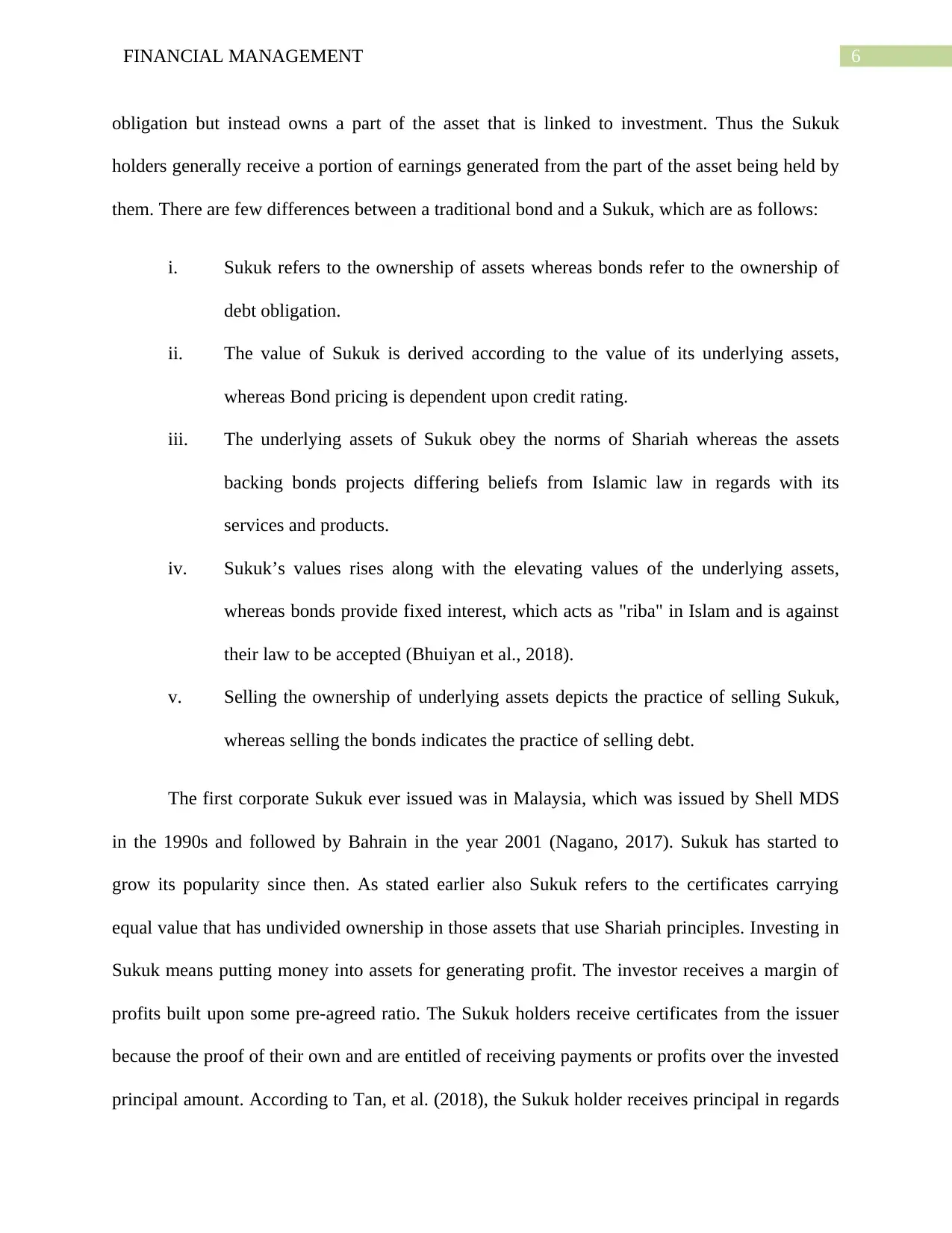
6FINANCIAL MANAGEMENT
obligation but instead owns a part of the asset that is linked to investment. Thus the Sukuk
holders generally receive a portion of earnings generated from the part of the asset being held by
them. There are few differences between a traditional bond and a Sukuk, which are as follows:
i. Sukuk refers to the ownership of assets whereas bonds refer to the ownership of
debt obligation.
ii. The value of Sukuk is derived according to the value of its underlying assets,
whereas Bond pricing is dependent upon credit rating.
iii. The underlying assets of Sukuk obey the norms of Shariah whereas the assets
backing bonds projects differing beliefs from Islamic law in regards with its
services and products.
iv. Sukuk’s values rises along with the elevating values of the underlying assets,
whereas bonds provide fixed interest, which acts as "riba" in Islam and is against
their law to be accepted (Bhuiyan et al., 2018).
v. Selling the ownership of underlying assets depicts the practice of selling Sukuk,
whereas selling the bonds indicates the practice of selling debt.
The first corporate Sukuk ever issued was in Malaysia, which was issued by Shell MDS
in the 1990s and followed by Bahrain in the year 2001 (Nagano, 2017). Sukuk has started to
grow its popularity since then. As stated earlier also Sukuk refers to the certificates carrying
equal value that has undivided ownership in those assets that use Shariah principles. Investing in
Sukuk means putting money into assets for generating profit. The investor receives a margin of
profits built upon some pre-agreed ratio. The Sukuk holders receive certificates from the issuer
because the proof of their own and are entitled of receiving payments or profits over the invested
principal amount. According to Tan, et al. (2018), the Sukuk holder receives principal in regards
obligation but instead owns a part of the asset that is linked to investment. Thus the Sukuk
holders generally receive a portion of earnings generated from the part of the asset being held by
them. There are few differences between a traditional bond and a Sukuk, which are as follows:
i. Sukuk refers to the ownership of assets whereas bonds refer to the ownership of
debt obligation.
ii. The value of Sukuk is derived according to the value of its underlying assets,
whereas Bond pricing is dependent upon credit rating.
iii. The underlying assets of Sukuk obey the norms of Shariah whereas the assets
backing bonds projects differing beliefs from Islamic law in regards with its
services and products.
iv. Sukuk’s values rises along with the elevating values of the underlying assets,
whereas bonds provide fixed interest, which acts as "riba" in Islam and is against
their law to be accepted (Bhuiyan et al., 2018).
v. Selling the ownership of underlying assets depicts the practice of selling Sukuk,
whereas selling the bonds indicates the practice of selling debt.
The first corporate Sukuk ever issued was in Malaysia, which was issued by Shell MDS
in the 1990s and followed by Bahrain in the year 2001 (Nagano, 2017). Sukuk has started to
grow its popularity since then. As stated earlier also Sukuk refers to the certificates carrying
equal value that has undivided ownership in those assets that use Shariah principles. Investing in
Sukuk means putting money into assets for generating profit. The investor receives a margin of
profits built upon some pre-agreed ratio. The Sukuk holders receive certificates from the issuer
because the proof of their own and are entitled of receiving payments or profits over the invested
principal amount. According to Tan, et al. (2018), the Sukuk holder receives principal in regards
Paraphrase This Document
Need a fresh take? Get an instant paraphrase of this document with our AI Paraphraser
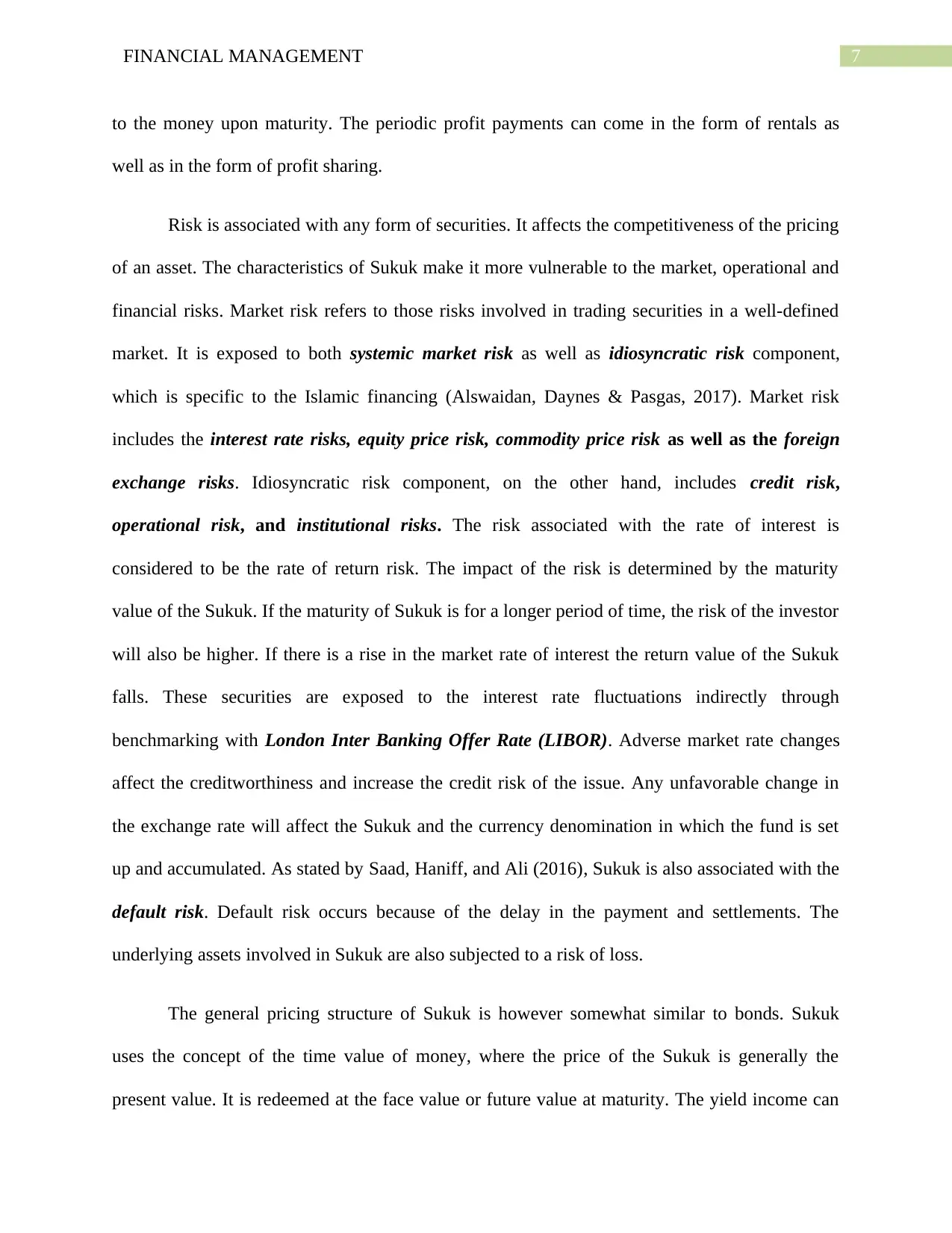
7FINANCIAL MANAGEMENT
to the money upon maturity. The periodic profit payments can come in the form of rentals as
well as in the form of profit sharing.
Risk is associated with any form of securities. It affects the competitiveness of the pricing
of an asset. The characteristics of Sukuk make it more vulnerable to the market, operational and
financial risks. Market risk refers to those risks involved in trading securities in a well-defined
market. It is exposed to both systemic market risk as well as idiosyncratic risk component,
which is specific to the Islamic financing (Alswaidan, Daynes & Pasgas, 2017). Market risk
includes the interest rate risks, equity price risk, commodity price risk as well as the foreign
exchange risks. Idiosyncratic risk component, on the other hand, includes credit risk,
operational risk, and institutional risks. The risk associated with the rate of interest is
considered to be the rate of return risk. The impact of the risk is determined by the maturity
value of the Sukuk. If the maturity of Sukuk is for a longer period of time, the risk of the investor
will also be higher. If there is a rise in the market rate of interest the return value of the Sukuk
falls. These securities are exposed to the interest rate fluctuations indirectly through
benchmarking with London Inter Banking Offer Rate (LIBOR). Adverse market rate changes
affect the creditworthiness and increase the credit risk of the issue. Any unfavorable change in
the exchange rate will affect the Sukuk and the currency denomination in which the fund is set
up and accumulated. As stated by Saad, Haniff, and Ali (2016), Sukuk is also associated with the
default risk. Default risk occurs because of the delay in the payment and settlements. The
underlying assets involved in Sukuk are also subjected to a risk of loss.
The general pricing structure of Sukuk is however somewhat similar to bonds. Sukuk
uses the concept of the time value of money, where the price of the Sukuk is generally the
present value. It is redeemed at the face value or future value at maturity. The yield income can
to the money upon maturity. The periodic profit payments can come in the form of rentals as
well as in the form of profit sharing.
Risk is associated with any form of securities. It affects the competitiveness of the pricing
of an asset. The characteristics of Sukuk make it more vulnerable to the market, operational and
financial risks. Market risk refers to those risks involved in trading securities in a well-defined
market. It is exposed to both systemic market risk as well as idiosyncratic risk component,
which is specific to the Islamic financing (Alswaidan, Daynes & Pasgas, 2017). Market risk
includes the interest rate risks, equity price risk, commodity price risk as well as the foreign
exchange risks. Idiosyncratic risk component, on the other hand, includes credit risk,
operational risk, and institutional risks. The risk associated with the rate of interest is
considered to be the rate of return risk. The impact of the risk is determined by the maturity
value of the Sukuk. If the maturity of Sukuk is for a longer period of time, the risk of the investor
will also be higher. If there is a rise in the market rate of interest the return value of the Sukuk
falls. These securities are exposed to the interest rate fluctuations indirectly through
benchmarking with London Inter Banking Offer Rate (LIBOR). Adverse market rate changes
affect the creditworthiness and increase the credit risk of the issue. Any unfavorable change in
the exchange rate will affect the Sukuk and the currency denomination in which the fund is set
up and accumulated. As stated by Saad, Haniff, and Ali (2016), Sukuk is also associated with the
default risk. Default risk occurs because of the delay in the payment and settlements. The
underlying assets involved in Sukuk are also subjected to a risk of loss.
The general pricing structure of Sukuk is however somewhat similar to bonds. Sukuk
uses the concept of the time value of money, where the price of the Sukuk is generally the
present value. It is redeemed at the face value or future value at maturity. The yield income can
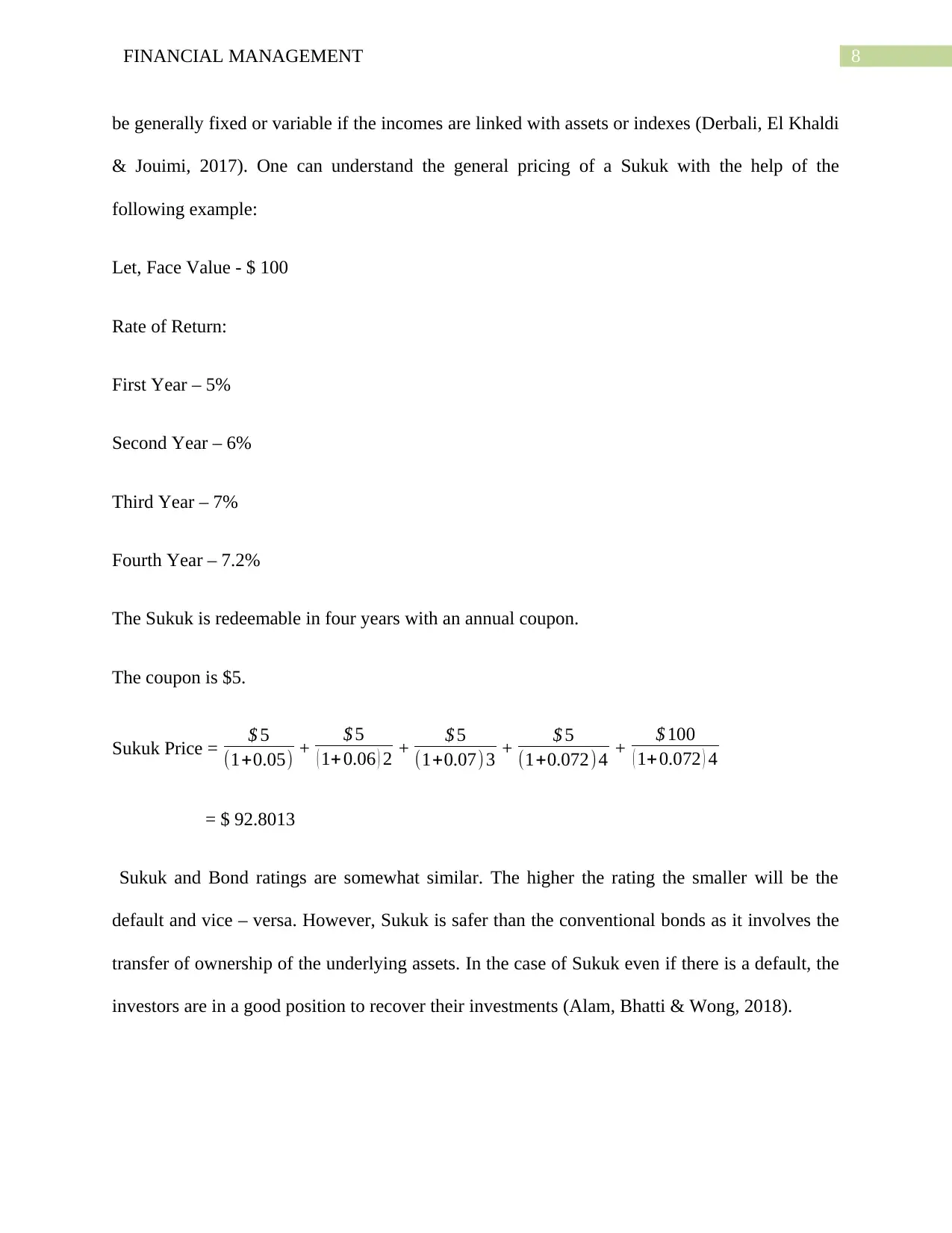
8FINANCIAL MANAGEMENT
be generally fixed or variable if the incomes are linked with assets or indexes (Derbali, El Khaldi
& Jouimi, 2017). One can understand the general pricing of a Sukuk with the help of the
following example:
Let, Face Value - $ 100
Rate of Return:
First Year – 5%
Second Year – 6%
Third Year – 7%
Fourth Year – 7.2%
The Sukuk is redeemable in four years with an annual coupon.
The coupon is $5.
Sukuk Price = $ 5
(1+0.05) + $ 5
( 1+0.06 ) 2 + $ 5
(1+0.07) 3 + $ 5
(1+0.072)4 + $ 100
( 1+ 0.072 ) 4
= $ 92.8013
Sukuk and Bond ratings are somewhat similar. The higher the rating the smaller will be the
default and vice – versa. However, Sukuk is safer than the conventional bonds as it involves the
transfer of ownership of the underlying assets. In the case of Sukuk even if there is a default, the
investors are in a good position to recover their investments (Alam, Bhatti & Wong, 2018).
be generally fixed or variable if the incomes are linked with assets or indexes (Derbali, El Khaldi
& Jouimi, 2017). One can understand the general pricing of a Sukuk with the help of the
following example:
Let, Face Value - $ 100
Rate of Return:
First Year – 5%
Second Year – 6%
Third Year – 7%
Fourth Year – 7.2%
The Sukuk is redeemable in four years with an annual coupon.
The coupon is $5.
Sukuk Price = $ 5
(1+0.05) + $ 5
( 1+0.06 ) 2 + $ 5
(1+0.07) 3 + $ 5
(1+0.072)4 + $ 100
( 1+ 0.072 ) 4
= $ 92.8013
Sukuk and Bond ratings are somewhat similar. The higher the rating the smaller will be the
default and vice – versa. However, Sukuk is safer than the conventional bonds as it involves the
transfer of ownership of the underlying assets. In the case of Sukuk even if there is a default, the
investors are in a good position to recover their investments (Alam, Bhatti & Wong, 2018).
⊘ This is a preview!⊘
Do you want full access?
Subscribe today to unlock all pages.

Trusted by 1+ million students worldwide
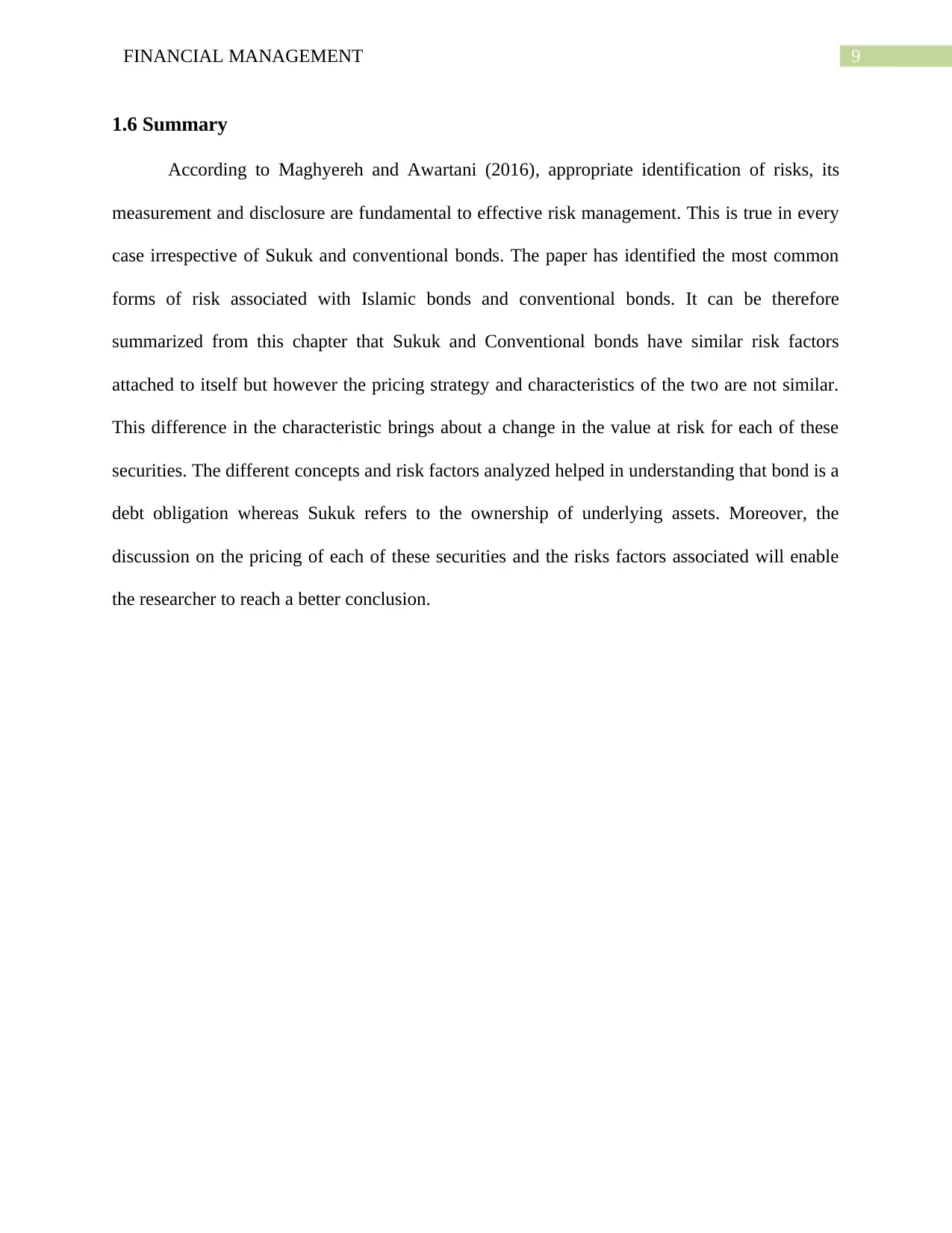
9FINANCIAL MANAGEMENT
1.6 Summary
According to Maghyereh and Awartani (2016), appropriate identification of risks, its
measurement and disclosure are fundamental to effective risk management. This is true in every
case irrespective of Sukuk and conventional bonds. The paper has identified the most common
forms of risk associated with Islamic bonds and conventional bonds. It can be therefore
summarized from this chapter that Sukuk and Conventional bonds have similar risk factors
attached to itself but however the pricing strategy and characteristics of the two are not similar.
This difference in the characteristic brings about a change in the value at risk for each of these
securities. The different concepts and risk factors analyzed helped in understanding that bond is a
debt obligation whereas Sukuk refers to the ownership of underlying assets. Moreover, the
discussion on the pricing of each of these securities and the risks factors associated will enable
the researcher to reach a better conclusion.
1.6 Summary
According to Maghyereh and Awartani (2016), appropriate identification of risks, its
measurement and disclosure are fundamental to effective risk management. This is true in every
case irrespective of Sukuk and conventional bonds. The paper has identified the most common
forms of risk associated with Islamic bonds and conventional bonds. It can be therefore
summarized from this chapter that Sukuk and Conventional bonds have similar risk factors
attached to itself but however the pricing strategy and characteristics of the two are not similar.
This difference in the characteristic brings about a change in the value at risk for each of these
securities. The different concepts and risk factors analyzed helped in understanding that bond is a
debt obligation whereas Sukuk refers to the ownership of underlying assets. Moreover, the
discussion on the pricing of each of these securities and the risks factors associated will enable
the researcher to reach a better conclusion.
Paraphrase This Document
Need a fresh take? Get an instant paraphrase of this document with our AI Paraphraser
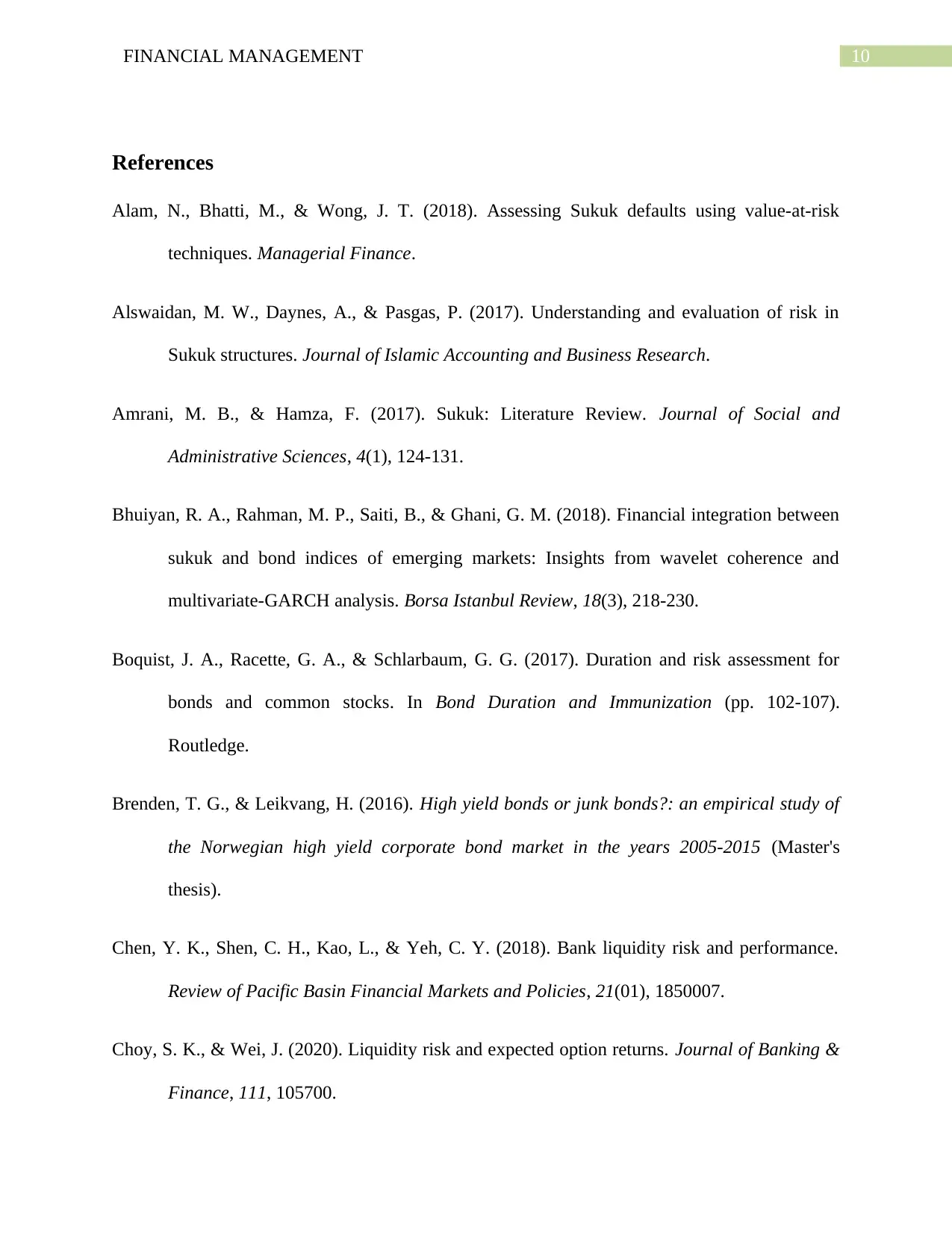
10FINANCIAL MANAGEMENT
References
Alam, N., Bhatti, M., & Wong, J. T. (2018). Assessing Sukuk defaults using value-at-risk
techniques. Managerial Finance.
Alswaidan, M. W., Daynes, A., & Pasgas, P. (2017). Understanding and evaluation of risk in
Sukuk structures. Journal of Islamic Accounting and Business Research.
Amrani, M. B., & Hamza, F. (2017). Sukuk: Literature Review. Journal of Social and
Administrative Sciences, 4(1), 124-131.
Bhuiyan, R. A., Rahman, M. P., Saiti, B., & Ghani, G. M. (2018). Financial integration between
sukuk and bond indices of emerging markets: Insights from wavelet coherence and
multivariate-GARCH analysis. Borsa Istanbul Review, 18(3), 218-230.
Boquist, J. A., Racette, G. A., & Schlarbaum, G. G. (2017). Duration and risk assessment for
bonds and common stocks. In Bond Duration and Immunization (pp. 102-107).
Routledge.
Brenden, T. G., & Leikvang, H. (2016). High yield bonds or junk bonds?: an empirical study of
the Norwegian high yield corporate bond market in the years 2005-2015 (Master's
thesis).
Chen, Y. K., Shen, C. H., Kao, L., & Yeh, C. Y. (2018). Bank liquidity risk and performance.
Review of Pacific Basin Financial Markets and Policies, 21(01), 1850007.
Choy, S. K., & Wei, J. (2020). Liquidity risk and expected option returns. Journal of Banking &
Finance, 111, 105700.
References
Alam, N., Bhatti, M., & Wong, J. T. (2018). Assessing Sukuk defaults using value-at-risk
techniques. Managerial Finance.
Alswaidan, M. W., Daynes, A., & Pasgas, P. (2017). Understanding and evaluation of risk in
Sukuk structures. Journal of Islamic Accounting and Business Research.
Amrani, M. B., & Hamza, F. (2017). Sukuk: Literature Review. Journal of Social and
Administrative Sciences, 4(1), 124-131.
Bhuiyan, R. A., Rahman, M. P., Saiti, B., & Ghani, G. M. (2018). Financial integration between
sukuk and bond indices of emerging markets: Insights from wavelet coherence and
multivariate-GARCH analysis. Borsa Istanbul Review, 18(3), 218-230.
Boquist, J. A., Racette, G. A., & Schlarbaum, G. G. (2017). Duration and risk assessment for
bonds and common stocks. In Bond Duration and Immunization (pp. 102-107).
Routledge.
Brenden, T. G., & Leikvang, H. (2016). High yield bonds or junk bonds?: an empirical study of
the Norwegian high yield corporate bond market in the years 2005-2015 (Master's
thesis).
Chen, Y. K., Shen, C. H., Kao, L., & Yeh, C. Y. (2018). Bank liquidity risk and performance.
Review of Pacific Basin Financial Markets and Policies, 21(01), 1850007.
Choy, S. K., & Wei, J. (2020). Liquidity risk and expected option returns. Journal of Banking &
Finance, 111, 105700.
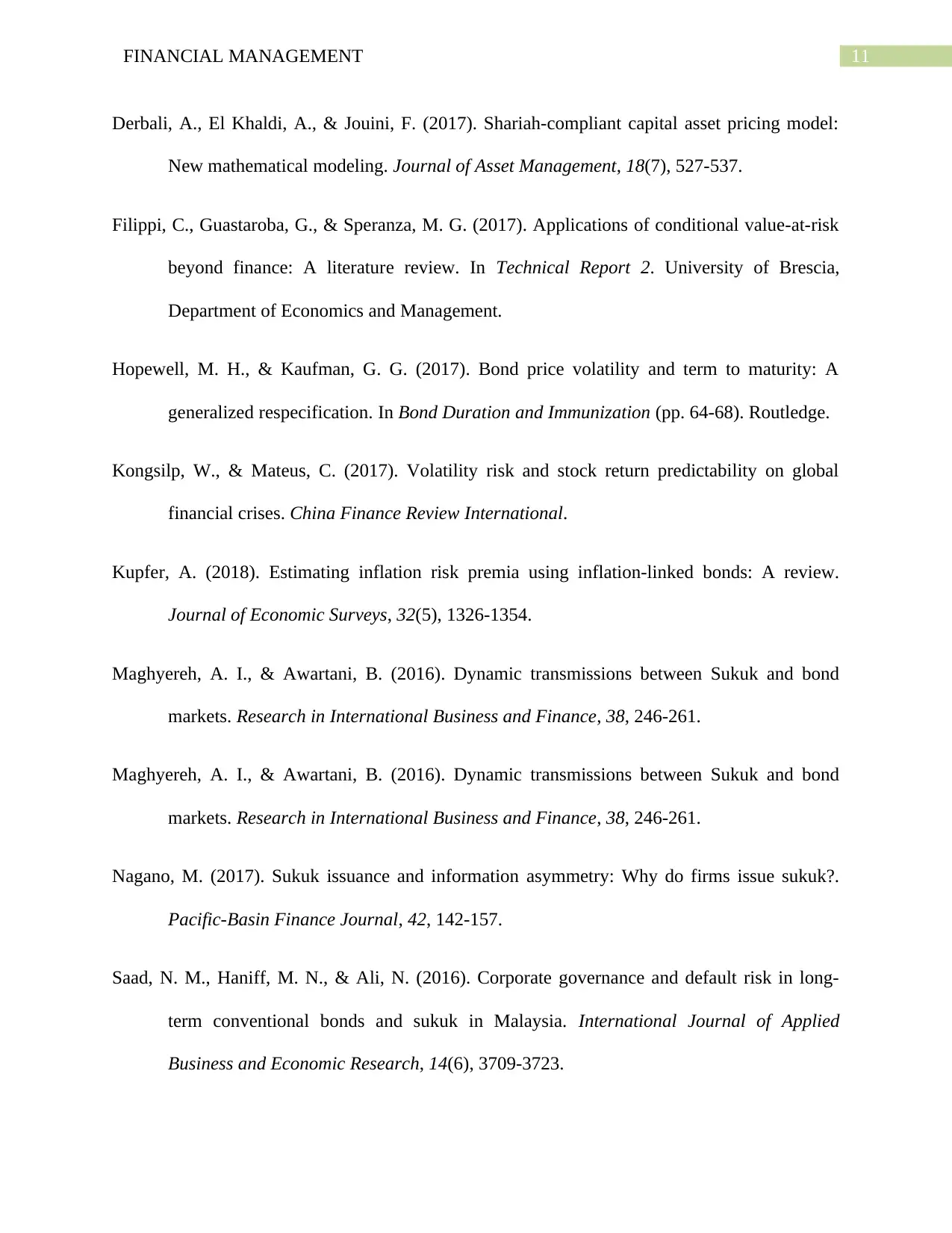
11FINANCIAL MANAGEMENT
Derbali, A., El Khaldi, A., & Jouini, F. (2017). Shariah-compliant capital asset pricing model:
New mathematical modeling. Journal of Asset Management, 18(7), 527-537.
Filippi, C., Guastaroba, G., & Speranza, M. G. (2017). Applications of conditional value-at-risk
beyond finance: A literature review. In Technical Report 2. University of Brescia,
Department of Economics and Management.
Hopewell, M. H., & Kaufman, G. G. (2017). Bond price volatility and term to maturity: A
generalized respecification. In Bond Duration and Immunization (pp. 64-68). Routledge.
Kongsilp, W., & Mateus, C. (2017). Volatility risk and stock return predictability on global
financial crises. China Finance Review International.
Kupfer, A. (2018). Estimating inflation risk premia using inflation‐linked bonds: A review.
Journal of Economic Surveys, 32(5), 1326-1354.
Maghyereh, A. I., & Awartani, B. (2016). Dynamic transmissions between Sukuk and bond
markets. Research in International Business and Finance, 38, 246-261.
Maghyereh, A. I., & Awartani, B. (2016). Dynamic transmissions between Sukuk and bond
markets. Research in International Business and Finance, 38, 246-261.
Nagano, M. (2017). Sukuk issuance and information asymmetry: Why do firms issue sukuk?.
Pacific-Basin Finance Journal, 42, 142-157.
Saad, N. M., Haniff, M. N., & Ali, N. (2016). Corporate governance and default risk in long-
term conventional bonds and sukuk in Malaysia. International Journal of Applied
Business and Economic Research, 14(6), 3709-3723.
Derbali, A., El Khaldi, A., & Jouini, F. (2017). Shariah-compliant capital asset pricing model:
New mathematical modeling. Journal of Asset Management, 18(7), 527-537.
Filippi, C., Guastaroba, G., & Speranza, M. G. (2017). Applications of conditional value-at-risk
beyond finance: A literature review. In Technical Report 2. University of Brescia,
Department of Economics and Management.
Hopewell, M. H., & Kaufman, G. G. (2017). Bond price volatility and term to maturity: A
generalized respecification. In Bond Duration and Immunization (pp. 64-68). Routledge.
Kongsilp, W., & Mateus, C. (2017). Volatility risk and stock return predictability on global
financial crises. China Finance Review International.
Kupfer, A. (2018). Estimating inflation risk premia using inflation‐linked bonds: A review.
Journal of Economic Surveys, 32(5), 1326-1354.
Maghyereh, A. I., & Awartani, B. (2016). Dynamic transmissions between Sukuk and bond
markets. Research in International Business and Finance, 38, 246-261.
Maghyereh, A. I., & Awartani, B. (2016). Dynamic transmissions between Sukuk and bond
markets. Research in International Business and Finance, 38, 246-261.
Nagano, M. (2017). Sukuk issuance and information asymmetry: Why do firms issue sukuk?.
Pacific-Basin Finance Journal, 42, 142-157.
Saad, N. M., Haniff, M. N., & Ali, N. (2016). Corporate governance and default risk in long-
term conventional bonds and sukuk in Malaysia. International Journal of Applied
Business and Economic Research, 14(6), 3709-3723.
⊘ This is a preview!⊘
Do you want full access?
Subscribe today to unlock all pages.

Trusted by 1+ million students worldwide
1 out of 13
Related Documents
Your All-in-One AI-Powered Toolkit for Academic Success.
+13062052269
info@desklib.com
Available 24*7 on WhatsApp / Email
![[object Object]](/_next/static/media/star-bottom.7253800d.svg)
Unlock your academic potential
Copyright © 2020–2025 A2Z Services. All Rights Reserved. Developed and managed by ZUCOL.




